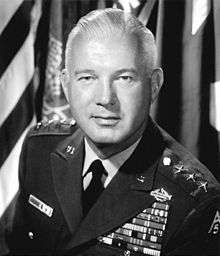John H. Michaelis
| John Hersey Michaelis | |
|---|---|
 John H. Michaelis as a lieutenant general | |
| Nickname(s) |
Iron Mike Colonel Mike |
| Born |
August 20, 1912 Presidio of San Francisco, California[1] |
| Died |
October 31, 1985 (aged 73) Clayton, Georgia[2] |
| Allegiance |
|
| Service/branch |
|
| Years of service | 1936-1972 |
| Rank |
|
| Commands held |
United States Forces Korea US Eighth Army |
| Battles/wars |
World War II Korean War Cold War |
| Awards |
Distinguished Service Cross Distinguished Service Medal (2) Silver Star (2) Legion of Merit (4) Bronze Star (3) Purple Heart (2) |
John Hersey Michaelis (August 20, 1912 – October 31, 1985) was a United States Army four-star general who served as Commander in Chief, United Nations Command/Commander, United States Forces Korea/Commanding General, Eighth United States Army (CINCUNC/COMUSFK/CG EUSA) from 1969 to 1972.
Michaelis was a 1936 graduate of the United States Military Academy. In World War II, he was executive officer of the 502nd Parachute Infantry Regiment, but took command of the unit after the commanding officer, George Van Horn Moseley, Jr., broke his leg on the drop into Normandy. Later, Michaelis was severely wounded in the Netherlands.[3] Other assignments include having served as aide-de-camp to Dwight Eisenhower from 1947 to 1948), and commanding the 27th Infantry Regiment known as the " Wolfhounds " at the Pusan perimeter during the Korean War, for which he received a Distinguished Service Cross.[4] As he commanded the "Wolfhounds" early in the war, most American units were not doing well because they were prone to break down and retreat. However his unit fared much better, General Matt Ridgeway believed, because of the fact that (then Colonel) Michaelis was an Airborne Commander and therefore did not panic whenever his unit was in danger of being surrounded. For as long as his unit had preserved 'unit integrity' with interlocking fields of fire then it could handle being surrounded and cut off as they could be resupplied from the air. It was to become an important template used by General Matt Ridgeway in his conduct of the Korean war once he assumed command from General MacArthur. General Matt Ridgeway's policy was to become one of " No more retreat " and he sought to acquire many more commanders like John Michaelis as the war continued. In fact, shortly after Ridgeway took command, he began to improve the Army's morale by sending the units north starting with Michaelis's unit under an offensive named Operation Wolfhound in their honor. Michaelis's unit began a new phase of the war that started a complete turnaround for U.N. troops.
Michaelis described the Turkish Brigade's combat readiness in unflattering terms, according to American historian Clay Blair. Blair wrote that war correspondents were misled into thinking that the Turks were "tough" fighters by their "flowing mustaches, swarthy complexions, and fierce demeanors", while in fact Blair declared them "ill trained, ill led, and green to combat."[5][6] Blair gave a quote from Michaelis: ''The Turks were commanded by an aged brigadier who had been a division commander at Gallipoli in 1916 fighting the British! He was highly respected, high up in the Turkish military establishment, and took a bust to brigadier to command the brigade. The average Turk soldier in the brigade came from the steppe country of Turkey, near Russia, had probably had only three or four years of school, was uprooted, moved to western Turkey, given a uniform, [a] rifle, and a little smattering of training, stuck on a ship, sailed ten thousand miles, then dumped off on a peninsula – ‘Korea, where’s that?’ – and told the enemy was up there someplace, go get him! The Turk soldier scratches his head and says, ‘What’s he done to me?"[7][8]
References
- ↑ United States Military Academy. Association of Graduates; West Point Alumni Association, Inc (1989). Assembly. 48. ISSN 1041-2581. Retrieved 20 August 2015.
- ↑ "Los Angeles Times: Archives - Retired Gen. 'Iron Mike' Michaelis Dies". pqasb.pqarchiver.com. Retrieved 20 August 2015.
- ↑ "Personalities and Commanders | "Iron Mike"". 101airborneww2.com. Retrieved 20 August 2015.
- ↑ "TIME magazine article April 06, 1959". time.com. Retrieved 20 August 2015.
- ↑ Blair 2003, p. 451.
- ↑ Blair 1987, p. 451.
- ↑ Blair 2003, p. 451.
- ↑ Blair 1987, p. 451.
- Blair, Clay (2003). The Forgotten War: America in Korea, 1950-1953 (illustrated, reprint ed.). Naval Institute Press. ISBN 1591140757. Retrieved 18 April 2014.
- Blair, Clay (Dec 12, 1987). The forgotten war: America in Korea, 1950. Times Books. ISBN 0812916700. Retrieved 18 April 2014.
External links
- "Gen John Hersey Michaelis (1912 - 1985) - Find A Grave Memorial". findagrave.com. Retrieved 20 August 2015.